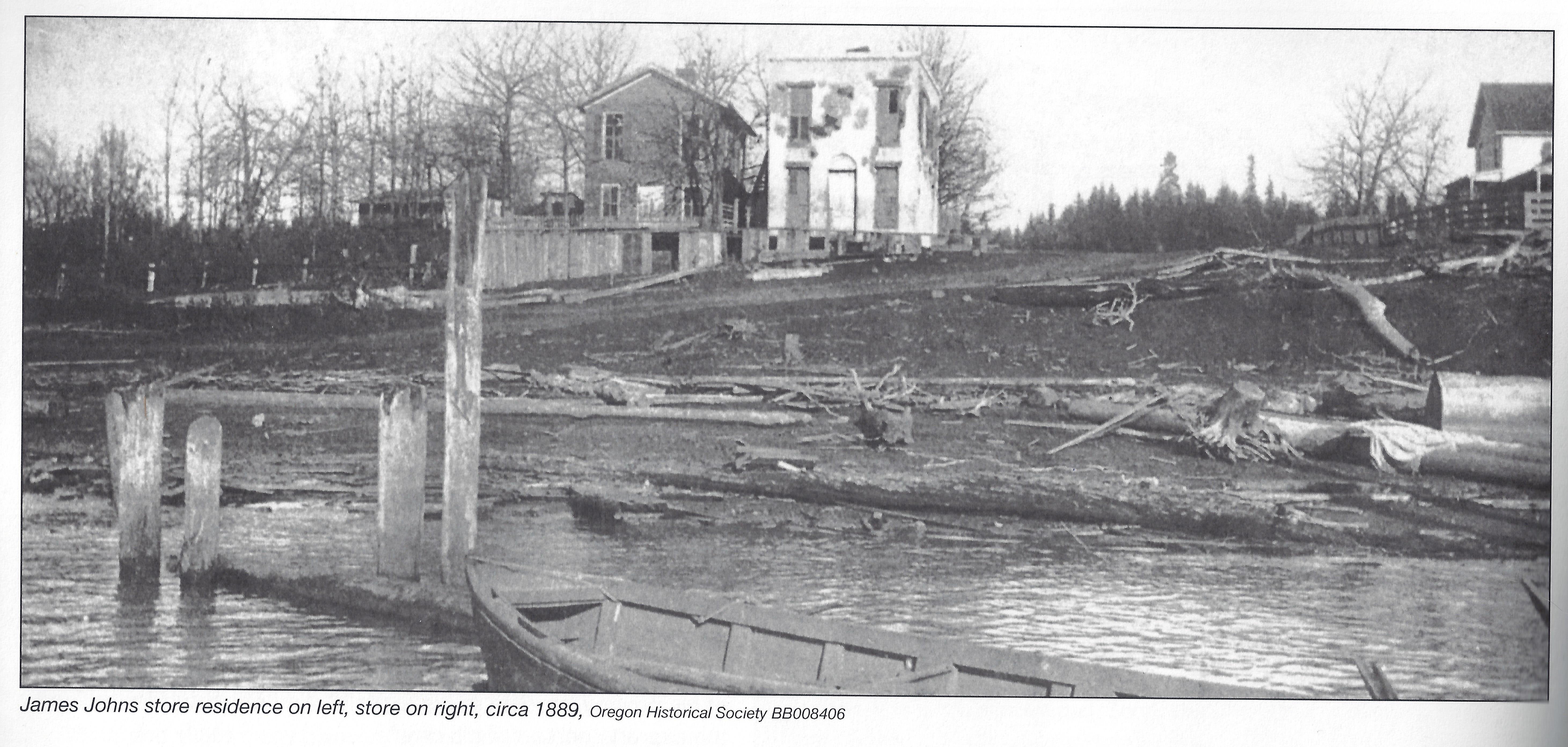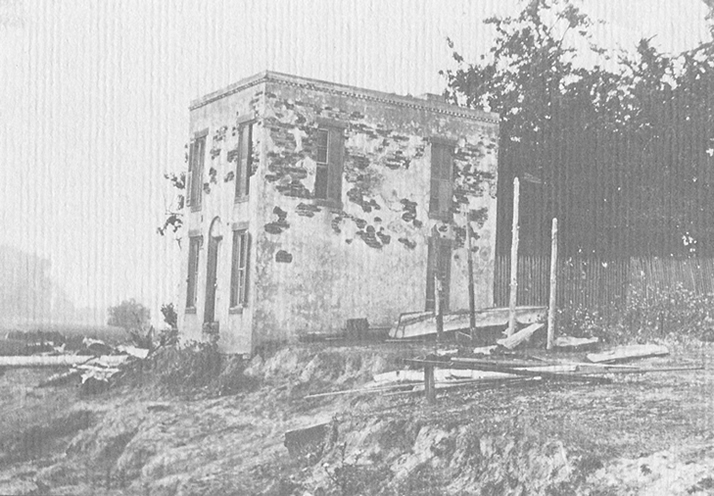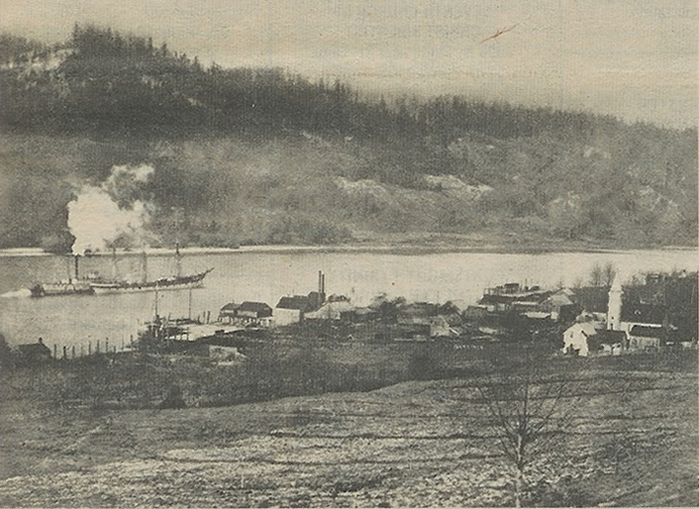St. Johns on the Willamette
St. Johns is one of the oldest cities on the Wilamette River. Its sister city, Linnton, is six months older than Portland.
James "Jimmy" John, the founder of St. Johns, was originally a developer and promoter of Linnton. John in anticipation of a population decline, had already moved to the east bank of the Willamette when Linnton became totally abandoned during the great gold rush to California in 1848.
John took up a provisional land claim on May 25, 1846, opposite Linnton, but a few miles further south and on higher ground where there had once been a large Indian encampment. This is the same location where William Clark, of Lewis and Clark fame, camped on his return from Waud's Bluff to the main body of the expedition.
By moving to the east side of the river John joined others on the Peninsula. Such men as James Loomis, Dr. William Caples, Daniel S. Southmayd, Sr., William Gatton, James Bybee, Fred Ramsey, Cuthbert Stump, Sr., Captain John Ward (Waud), and Henry Much (Mock), father of John Moch.
They all became permanent residents with the exception of Stump who soon sold out and moved to Scappoose. Many descendants of Caples and Gatton stayed in the general area. Southmayd's youngest son, Starr Southmayd, moved to Sherwood with his mother and stepfather but returned to St. Johns in 1904.
The original townsite was only four bocks along the waterfront and 2 1/2 blocks in depth, bound on the north by Burlington Avenue and on south by Richmond Avenue. It was platted on Oct. 7, 1852 and aptly entitled "St. Johns on the Willamette."
It was here, just before the Civil War, that Benjamin O. Severance, as owner, and his son-in-law, Albert L. Learned, as superintendent, began operating the Oregon Barrel Co., the largest manufacturing plant in the metropolitan Portland area.
Cottonwood abounded along the local sloughs and when barrels were no longer used for shipment of sugar, the plant turned to the manufacturing of wooden wash tubs, chair rungs, and contemporary wood products. This was the first industry to locate in St. Johns.
 Photo found in A Pictorial History of St. Johns by Donald R. Nelson
Photo found in A Pictorial History of St. Johns by Donald R. Nelson
During the same period John was operating a ferry and general store at the base of Burlington Avenue on the north side of the street, adjacent to the platted town. It is believed that the store was built at the the same time the first brick store was built in Portland in 1853. He also built a brick house in the same locale at a later date. It is here that he died in 1886.
 James John's brick store. Note ferry boat next to building.
James John's brick store. Note ferry boat next to building.
When St. Johns was finally incorporated as a city in 1903, the Portland Manufacturing Co., A.B. Douglass & Sons Planning Mill, M.B. Rankin's (electrical) sawmill and the Port of Portland's dry dock were already established industries.
The fledgling city needed a newspaper to handle it's legal notices and the St. Johns Review came into existence on Nov. 11, 1904, for just that purpose. A second newspaper, the Peninsula Herald, competed for subscriptions and advertisers for a short period of time, but there wasn't enough business to go around and the enterprise collapsed.
The St. Johns Review is the oldest continuously published community newspaper in Portland. The community, like the City of Portland itself, grew rapidly in 1906 after the Lewis and Clark Exposition, but it soon settled down to a more gradual and orderly growth pattern.
The Portland Woolen Mills, which was burned out of it's Sellwood location, re-established itself in St. Johns in 1904 on property furnished by the city council. It was the largest mill west of Cleveland and added a stabilizing influence to the community. It never shut down once during the Depression and there were no layoffs.
St. Johns became a "boom town" during both world wars by rapid industrial growth. Some residential expansion, to a lesser degree, also took place. The town proved itself to be the industrial giant of the metropolitan Portland area, the true "Manhattan of the West."
Public transportation was available from 1890 when the Willamette Bridge Co. steam trains reached St. Johns. Thomas J Monahan, St. Johns Postmaster and life-long resident, was the first conductor on the first train to reach the United States National Bank's parking lot, which was then the railroad's turntable.
Streetcars replaced the steam trains by 1903 when a booster transformer was installed at the Piedmont substation. Trackless trolleys and buses replaced the former modes of transportation, but each more successive type closely followed the original route established for the steam trains.
St. Johns became incorporated into Portland in 1915. It's city hall, completed in 1907, is the only permanent structure owned by any of the many suburban municipalities that form the present City of Portland. The fire bell is a real oddity. It is of steel alloy, weighs a ton, only cost $100 and was delivered a year ahead of time. It is barely audible at best and was once described by the editor of the Review as being no more efficient than beating upon an old wash pan.
The St. Johns city hall building and and the St. Johns Bridge were the only two registered Portland Historical Landmarks as late as 1980.
The St. Johns Suspension Bridge, one of the architectural beauties of the world, was conceived in the minds of many local men (including James John, A.W. Markle and Thomas J. Monahan) long before planning or construction actually began. The whole process, once it began in earnest, took 7 years.
Borings for suitable rock or hard sand foundations for main piers were completed in January 1929.
On Saturday June 13, 1931, the bridge was completed and formally dedicated. Alfred Staehli in his book "Preservation Opinions for Portland Neighborhoods," said: "The story of the building of St. Johns Bridge is one of successful commercial boosterism followed by a failure to achieve the hoped-for benefits which the new bridge was supposed to bring." Unfortunately that was a true statement.
Traffic was a real problem during World War II, as news-paper reports of the day will attest, and the fact this appears to be a ongoing problem should come as no surprise.
The area has had a glorious but somewhat stormy political past during its incorporated period (1903-1915); however, its future should be just as rewarding to its present and future residents as it was those who went this way before.



